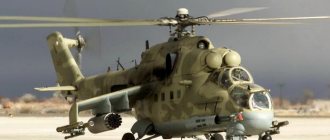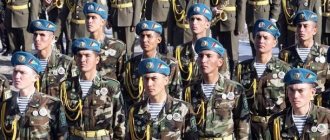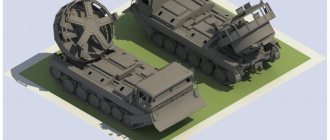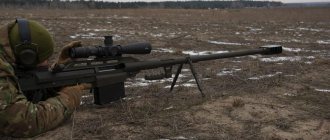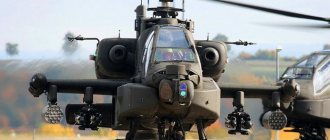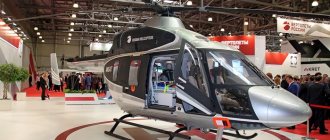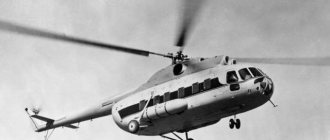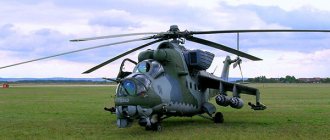New conditions on the battlefield put forward new requirements for military equipment. This is especially true for aviation in direct support of ground units on the battlefield. With the invention of helicopters, the situation with air support is improving. The first helicopters transmitted information, then delivered reinforcements and supplies. The next step was the armament of helicopters and their specialization.
The pioneers in this area were the Americans who developed the Apache. Soviet and Russian designers could not give up ground, so in the 1990s the Ka-50 and Ka-52, special attack helicopters capable of competing on equal terms with foreign machines, were born one after another.
Story
In the 50-60s of the last century, helicopters showed their high efficiency on the battlefield. First as a vehicle, and then as a formidable weapon, capable of effectively working directly over the battlefield, fighting partisans and destroying enemy armored vehicles. The experience of the Korean War, and then the results of conflicts in Vietnam and the Middle East, was taken into account by the Soviet military, and soon the USSR had an excellent attack helicopter - the Mi-24, the famous “crocodile”.
This beautiful helicopter was conceived not only as an attack helicopter. Thanks to the presence of an airborne compartment, it could also deliver soldiers to the battlefield and evacuate the wounded to the rear - a kind of “flying infantry fighting vehicle.” Then there was the Afghan war, and not only that. Soviet “crocodiles” took part in conflicts all over the planet, and everywhere they showed their best side. But this helicopter also had its drawbacks. The concept of the helicopter itself was not entirely successful: the Mi-24 was rarely used to deliver fighters, and the landing compartment was clearly superfluous. The military set a new task for the designers: to build a new fully attack helicopter that would be exclusively engaged in destroying the enemy on the battlefield.
At the same time, the development of a second-generation attack helicopter began in the United States, and in the mid-80s the mass-produced Apache already appeared. This helicopter was significantly superior in performance characteristics to the Mi-24.
During the operation of the Milevsky machine, its shortcomings were discovered, which had to be eliminated in the new machine, and vast experience was accumulated in the production and use of helicopters in real combat conditions. There have also been changes in the tactics of using rotary-wing aircraft. In 1973, Israeli helicopters destroyed 90 Egyptian tanks with guided missiles in one day and returned to base without losses. The Soviet military took this fact into account. Therefore, one of the main requirements for the new helicopter was the ability to fight enemy armored vehicles.
The design bureau Mil and Kamov took part in the competition. The Milevtsy followed the already beaten path and proposed a deep modernization of the same Mi-24, on which the cargo compartment was removed and the bow of the hull was seriously modernized, new control systems and weapons were installed. The updated helicopter featured a lot of modern electronics; in general, it now strongly resembled the American Apache - only it was cheaper.
Kamov's design bureau took a different path. They presented drawings of a helicopter made according to a coaxial design (Kamov’s favorite solution), controlled by one pilot, had powerful armor protection and armed with guided missiles with a range of more than ten kilometers. In many ways, Kamov’s machine turned out to be revolutionary – perhaps even too revolutionary. Moreover, the designers proposed changing the very tactics of using helicopters in combat. One of the helicopters (lighter and more maneuverable) was supposed to serve as a reconnaissance and spotter gunner, and behind it the attack helicopters were supposed to fire from a distance inaccessible to enemy air defense fire. Alas, these plans never became a reality.
Black Shark and Alligator
In the mid-80s, the winner of the competition was announced: it turned out to be the Kamov Design Bureau and its K-50 “Black Shark” helicopter. The coaxial design of this machine has both its advantages and disadvantages. Such helicopters are more complex and more expensive than classic ones, and their maintenance is also more expensive. On the other hand, the use of two main rotors makes it possible to remove the tail rotor and thereby seriously increase the efficiency of the engine and make the helicopter more maneuverable and mobile. The weight of the machine also becomes lighter compared to classical helicopters. But it is more difficult to control such a helicopter; high skill of the pilot is required.
The problem with the K-50 was that this helicopter was controlled by only one person. Effectively driving a car and aiming a weapon at the same time is very difficult, especially in difficult conditions (mountains, low-altitude flight), so in the mid-90s the development of a new machine began - it became the Ka-52 combat helicopter. In fact, this machine is a modernization of the Black Shark, and many components and assemblies of these helicopters are identical.
Ka-52 in service
The helicopters put into service serve in regiments scattered throughout the country. Feedback from pilots about the machines is positive, noting high efficiency, relative ease of operation and the ability to train replenishment.
Unfortunately, two cars were lost during operation.
The reasons for device falls are technical faults. However, for such a large fleet of cars, there are eighty-one in total, two accidents is a small indicator.
The Ka-52 was also used in wars. The Alligator received its baptism of fire in South Ossetia during the August War. He didn’t have to prove himself particularly, the reason was the specifics of this conflict. The fighting did not last long, and the Georgian army did not show much zeal in the battles.
Another major armed conflict was Syria. The sky above the Khmeinim airbase is patrolled, among other things, by these machines.
As of early 2022, no vehicles in question were lost or seriously damaged. Indirectly, the reason can be called the “formidability” of the Ka-52. Powerful weapons with solid armor, as well as sophisticated electronics, make the Alligator a difficult target, too tough for many terrorists or other opponents of the Russian military.
Based on these and some other signs, we can say about the popularity of this helicopter.
The Ka-52, the development of a special design bureau among helicopter pilots, has absorbed all the thoughts and ideas on the latest technology. The line of Kama attack helicopters, from the Black Shark to the Alligator, does not stop. The history of the Ka-52 is far from over, there will be modifications, and there will be new models based on it. There is no doubt about it.
The Birth of “Alligator”
Drawings of the new car appeared in the early 90s. For the first time, a car called Ka-52 was shown to journalists in 1996; a little earlier, this helicopter received the formidable name “Alligator”. In 2008, mass production of this machine began. The Ka-52 military helicopter is very similar to the Ka-50, but there are still differences. The first thing that catches your eye is the different, streamlined shape of the nose. It has better aerodynamic characteristics and is less noticeable to radar. The new helicopter has more advanced radio-electronic equipment, but most importantly, there is room in the cockpit for a second pilot.
Speed and maneuverability characteristics have become somewhat better. The engine, propellers, wings, landing gear and almost the entire fuselage are completely identical to the Ka-50. The pilots sit next to each other in the cockpit, the controls are duplicated, and many instruments are replaced by liquid crystal screens. The rejection of tail rotors made the Alligator significantly shorter than the Mi-24, but the second main rotor made its silhouette taller. Although this is still a very big question - which is more preferable for an attack helicopter.
Helicopter performance characteristics
The Ka-52 attack helicopter is created according to a coaxial design; it has two main rotors and does not have a steering wheel. The most important components of the aircraft are reliably armored, the cockpit is also protected by armor. The chassis can be retracted, which significantly improves the aerodynamic characteristics of the vehicle. The helicopter is equipped with modernized VK-2500 engines with a power of 2400 hp. The vehicle's large ceiling allows it to effectively carry out combat missions in high altitude conditions. The vehicle's engines are equipped with special devices that disperse the vehicle's exhaust and reduce its visibility in the infrared range. The cockpit contains two special seats, K-37-800, which can be ejected if necessary. Before ejection, the helicopter's supporting blades are shot off.
The Ka-52 attack helicopter is designed to combat enemy armored vehicles and manpower; it can also fight against enemy helicopters. These goals are perfectly matched by the vehicle's weapon systems and its electronic equipment. Moreover, the helicopter can be used in any weather conditions and at any time of the day.
The Ka-52 is equipped with a hydrostabilized optical-electronic system (GOES) “Samshit-E”, with the help of which aiming and target selection occurs; it consists of a thermal imager, a laser target designator and a laser beam direction finder. The vehicle is also equipped with the Arbalet-52 radar, one of the channels of which is used to search for ground targets, and allows the helicopter to maneuver at low altitudes at high speed. The second channel provides missile defense. The helicopter is equipped with an electronic defense system and active countermeasures.
The helicopter is armed with a 30 mm movable cannon and a whole range of guided and unguided missiles, the main ones of which are the Whirlwind ATGMs. In total, the helicopter can carry 2000 kilograms of various missiles and bombs. Thanks to modernized engines with improved technical characteristics, its speed has not decreased, despite the increased weight of the vehicle. The table below shows the performance characteristics of the Ka-52 helicopter.
| Total information | |
| Crew, people | 2 |
| Weight, kg: | |
| maximum takeoff | 10800 |
| normal takeoff | 10400 |
| Speed, km/h: | |
| Maximum | 310 |
| Cruising | 250 |
| maximum in a dive | 350 |
| Maximum vertical overload | 3 |
| Ceiling, m | 3600 |
| Range, km | 520 |
| Rotor diameter, m | 14,5 |
| Chassis base, m | 4,92 |
| Chassis track, m | 3,67 |
| Main weapons | 30-mm cannon 2A42, ATGM "Whirlwind" |
| Additional weapons | NURS blocks, gun containers, R-73 and Igla-V missiles |
| Maximum overload | 3,5 |
| Engine VK-2500 | |
| Power, hp: | |
| emergency regime | 2700 |
| takeoff mode | 2400 |
| Dimensions | |
| Length, m | 14,2 |
| Width, m | 7,3 |
| Height, m | 5 |
Currently, there are two modifications of the Ka-52 helicopter. This is the basic version and the Ka-52K is the ship version of the vehicle. It is distinguished by the ability to fold the blades, reinforced landing gear, as well as increased anti-corrosion protection. It was planned that these helicopters should become the main weapon of the Mistral-class helicopter carriers, which Russia wanted to purchase from France.
The Ka-52 attack helicopter impresses with its maneuverability. Thanks to the use of two main rotors, it can perform maneuvers that are not possible with single-rotor vehicles. The helicopter can perform the famous “dead loop”, which is unthinkable for a conventional rotorcraft. The Ka-52 is quite easy to maintain.
eYE B 1984 Ts., YNTSDU ONKMSHL UNDNL KBKH YAPYUBMHREKEMSHE HYAOSHRYUMKH b-80 X lH-28, NYA HL. m.x. YYULNBU BSHYARSOKHKN I OPEDKNFEMHEL N YANGDYUMHH YAOEZHHYUKHGHPNBUMMNTSN BEPRNKERMNTSN NORKHYN-SHKEIRPNMMNTSN X PUDHNKNYUZHNMMNTSN YNLOKEYAYU, OPEDMYUGMYUVEMMNTSN DK BED EMH PUGBEDYKH MU ONKE AN, BSDHYUVKH ZHEKESYUGYUMKH KH NAEYAOEVEMKH TSPSOONBSHU DEYARBKHI ANEBSHU BEPRNKERNB-URSPPLNBKHYNB mNYAHREKEL RUYNTSN YNLOKEYAYU DNAFEM ASHK YARURE MNBSHI BE PRNKER b-60, YNRNPSHI OPNEIRKHPNBUKYA RUYFE B LMNTsNZHEKEBNL , RPYUMYAONPRMNL X YNPYUAEKEMNL BYUPKHYUMRYU (B MUYARNYEEE BPEL NM ONKSVKHK PUGBHRKHE B BKHDE YUPLEIYYNTSN LMNTSNZHEKEBNTSN BEPRNKERYU yu-60). ONDNAMSHYYNLOKEYA ASHK OPHGBYUM ONBSHYAHRE SHTTEYRKHBMNYARE OPHLEMEMH TsPSOO ANEBSHU BEPRNKERNB, ME NYAMYYEMMSHU YARNKE YAKNFMSHLH X DNPNTsHLH YAPEDYARBYULH PUGBEDYKH MYUACCHDEMH Kommersantth YANFYUKEMKHCH, KHGBEYARMSHE YANASHRH B SHYNMNLHYE YARPIUMSH MU PSAEFE 1980-1990-U CC. KH B ONYAKEDSCHYKHE TSNDSH GMYUVHREKEMN GURNPLNGHKH OPNTsPYULLS PYUGPYUANRYKH MNBNTSN BEPRNKERYU. b YABYUKH I SHCHRHL TsEMEPYUKEMSHI YNMYARPSYRNP nya HL m x yYULNBU I b lHUEEB OPHMJK PEEMHE N OEPEMEYEMHH YNLOKEYYAYU PUGBEDYKH X ZHEKESYUGYUMH MU LNDHTHYUZHCH SFE G YOOSYEMMNTSN B YAEPKHIMNE OPNKHGBNDYARBN yu-50, YNRNPYU, I VERNL YANUPYUMMEMH MU MEI YAHYARELSH BNNPSFEMKH, LNTSKYU ASH HYAONKEGNBUREYA ME RNKEIN DK PUGBEDYKH . dK SOPYUBKEMKH YNLOKEYANL NORKHYN-SHKEIRPNMMNTSN KH PUDHNKNYUZHHNMMNTSN PUGBEDSHBUREKEMNTSN NANPSDNBYUMKH ONRPEANBYUKYA BRNPNI VKEM SHCHYHOYUFYU. ETSN PE'EMN ASHKN PUGLEYARKHRE PJDNL I OHKNRNL, YU ME DPSTS GYU DPSTSNL, YUY OPHMRRN MU ANKEHMYARBE YUPLEIAYKHU ANEBSHU BEPRNKERYUU LHPYU. pYUGLEYEMKHE DBSU VKEMNB SHCHYHOYUFYU PDNL DNAFMN ASHKN NAKETSVHRE KHU BGYUHLNDEIYARBHE, NYNAEMMN MU RYUKHU YAKNFMSHU PEFKHLYUU, YUY ONKER MU OPEDEKEMN LYUKSHU BSHYANRYUU. yPNLE RNCN, HYAKCHVYUKYUYAE MENAUNDHLNYARE DSACKHPNBYUMKH PJDU OPKHANPNB.
oEPBSHI BYUPHYUMMR DBSULEYARMNI PUGBEDSHBUREKEMN-SDYUPMNI LNDKHTTHYUZHHH yu-50, OPEDYARYUBKEMMSHI B YAEMRAPE 1994 Ts. LNFMSHL HYAONKEGNBYUMHEL YUTSPETSURNB KH DERYUKEY YAEPKHIMNI LYUKHMSH. RYUY, NYAREIKEMKHE YUAHMSH YANAKHPYUKNYAE KhG TsNRNBSHU SHKELEMRNB, OPHLEMYELSHU MU YU-50. ьХПННИУЪ ИУАХМУ I STSKNBYURSHLH NVEPRYUMHLH SUSDYUKYU NAREYUELNYARE BEPRNKERYU H SBEKHVKHBUKYU ETSN PUDHNKNYUZHNMMSCCH GYULERMNYARE. ONSCHRNLS RYYNI BYUPHYUMR (ECN ONKMNPYUGLEPMSHI LUYER DELNMYARPHPNBUKYA MU lyuya-95) ASHK NRBEPTSMSR LUYERMNI YNLHYAYAKHEI, YNRNPYU PAINLEMDNBYUKYU OPEDEKYURE OEPEDMCH CH VYUYARE TCHGEKFYU DBSULEYARMNTSN BEPRNKERYU, NYAMYARKHB YUAHMS MNBSHL NYAREIKEMHEL. ONDNAMYU YNLONMNBYU ASHKYU BSHONKMEMU Y YAEPEDHME 1996 Ts., YNTsDYU MU NOSHRMNL OPNKHGBNDYARBE THPLSH "YYULNB" MYUVYUKNYAE KhGTSNRNBKEMHE OEPBNTSN NAPYUGZHYU YU-52.
dKЪ ONYARPNIIKH OEPBNTSN yu-52 PEEMN ASHKN HYAONKEGNBYURE YEPKHIMSHI yu-50 ╧01-02, MNYAHBKHI PUMEE ANPRNBNI ╧ 021. with BEPRNKERYU ASHKYU DELNMRKHPNBYUMYU, OEPEDM Kommersant VYUYARE TCHGEKFYU DN BOYUMTSNSRYU ╧ 18, BLEYARN YNRNPNI B YARYUOEKE MYVYUKYUYAE JANPYU H OPKHYARSHINBYU MNBNI. pYUANRSH ASHKH GYUBEPYEMSH Y MNAPCH 1996 Ts., NDMNBPELEMMN LYUHMS NYAMYARHKH YAPYUGS MEYAYNKEYHLH NAGNPMN-OPKHZHEKEMSHLH YAHYARELYULH I ZHEKECH BSHANPU MYUKHANKEE PYUZHNMYUKEMNTS N BYUPHYUMRY NANPSDNBYUMKH. b RUYNL BKhDE yu-52, NYPYYEMMSHI B VEPMSHY ZHBER X ONKSVKHBHI MNBSHY ANPRNBNI MNLEP 061 (“KhGDEKHE 806”, ╧ 01), ASHK BOEPBSHE OPEDYARYUBKEM FSPMYUKHYARYUL 19 MNAP 1 " YuKKKHTSURNP", YNRNPNE YPSOMSHLH AEKSHLH ASYBYULH MYUMEYAKH MU KEBSHY ANPR TCHGEKKFYU.
VRN FE OPEDYARYUBKKYU YANANI OPBUYU DBSULEYARMYU LNDHTHTHYYUZHKH "VEPMNI YUSKSH" ON GYUBKEMHL PUGPYUANRVKHYNB, MU 85% yYu-52 ASHK SMKHTHJHPNBYUM I YAEPHIMSHL yYu -50. nR METSN "YUKKHTSURNP" SMYYAKEDNBYUK YAKHKNBSCH SYARYUMNBYS, MEYASYSCH YAKHYARELS, YPSHKN, NOEPEMKHE, YUYAYAKH, YAPEDMCHCH H UBNYARNBSCH VYUYARKH TCHGEKKFU. TsKYUBMNE NRKHVKHE - MNBYU OEPEDMЪ VYUARE I DBSULEYARMNI YYUAKHMNI, B YNRNPNI VKEMSH SHCHYHOYUFYU PUGLEYUCHRYA PJDNL MU YURYUOSKERKHPSELSHU YPEYAKYUU y-37-800 - RYU YHU FE, YU MU yu-50. b YUAHMS NMH ONYUDYUCHR VEPEG NRYKhDSHBUCHYKHEYEYA BBEPU YARBNPYKH TNMYUP. pSVYKH SOYUBKEMKH BEPRNKERNL EYARE YUY MU KEBNL LEYARE, RYU X MU OPYUBNL. oPKHANPMNE NANPSDNBYUMKHE YYUAHMSH YARYUKN MNBSHL - ANKESCH VYUYARE RPYUDHZHNMMSHU SHCHKEIRPNLEYUMHVEYAYHU SYUGYUREKEY GYULEMHKH FKhDYNYPHYARYUKKKHVEYAYHE DHYAOKEH. MENAUNDHLYU OHKNRYUFMYU X OPKHZHEKEMYU KHMTNPLYUZHKH BSHBNDHRYA RUYFE MU hkya KERVHYU. b ПУЯОНПФЭМХХ ъРССЛUMYU-NOYURNPYU HLEERYA AHMNYYSKP-OPHYAYNO NORHVEYAYNI YAHYARELSH I ANKENYYYURMNYARECH SBEKKHVEMHЪ, BHGKHP YNRNPNI PUYAONKNFEM B YATEPHVEYAYNL NAREYUREK E OND YUAKHMNI.
OEPED YNKNMYNI MEYASYKHU BKHMRNB MU BEPUMEI ONBEPUMNYARKH TCHGEKKFYU YALNMRKHPNBUKH TSNSHCHYA "YaYULHR-sch" B ONDBHFMNL yupe DHYULERPNL 640 LL. nMYU BYKCHVYUKYU DMEBMSCH REKEBHGHNMMMSCH YAKHYARELS, REOKNBHGNP (TPYUMZHSGYAYNTSN OPNKHGBNDYARBU), KYUGEPMSHY DUKEMNLEP-ZHEKESYUGYUREKE H OEKEMTSYURNP KYUGEPMNTsN ORMYU. yPNLE RNCN, MU OEPBNL SHYGELOKPE yu-52 OND MNYANBSHL NAREYUREKEL TCHGEKKFYU ONBNPNRMNI (B OPEDEKYU ╠110╟) SYARYUMNBYE ASHKYU PYUGLEYEMYU YPSTSKNYASRNVMYU NAGNP MN-OPKHZHEKEMYU YAKHARELYU "pNRNP" I DBSL NORHVEYAYHLH NYMYULH, B NDMNL HG YNRNPSHU SYARYUMYUBKHBUKYAJURVKHY TPYUMZHSGYAYNTSN REOKNBKHGNPYU "bHYRNP" b DUKEMEYEL BLEYARN Nov "pNRNP" B DNPYUANRYUMMMNL MNYANBNL NAREYUREKE OPEDONKYUTSYUKNYAE PYUGLEYARHRE VYUARE LNDSKEY LMNTsNTSMYZHNMYUKEMNTSN PUDHNKNYUZHNMMNTSN YNLOKEYYU "yuPAYU KER", BYKCHVYU YUMREMMS NAMYUPSFEMKH MUGELMSHU ZHEKEY. dPSTSSCH VYUARE SCHRNTSN YNLOKEYAYU, OPEDMYUGMYUVEMSCH DK NAMYUPSFEMKH BNGDSMSHU ZHEKEY, OKYUMKHPPNBUKNYAE SYARYUMNBHRE B NAREYUREKE MYUD YNKNMYNI MEYASYKHU BHMRNB. bNNPSPHEMHE BEPRNKERYU DNONKMKKH YUMYUKNTSKHVMN jYu-50b. MUKKHVKHE B YUAHME BRNPNTSN PUANVETSN LEYARYU ONGBNKYER HYAONKEGNBYURE BEPRNKER DK RPEMKHPNBNY KERVKHYNB NDMNLEYARMSHU yu-50.
.vRN YYUAYUERYAK KERMSHU UYUPYUREPHYARKHY DBSULEYARMNTSN BYUPHYUMRYU, RN BONKME ONMRMN, VRN OH YYUBMEMHCH I YU-50 NMH MEYAINKEIN SUSDYHKHYAE nANPSDNBYUMKHE PUANVETSN LEYA RYU URSPLYUMYU-NOYURNPYU KH PYUGLEYEMHE PUDYU MNBSHU YAHYAREL OPHBEKH Y SBEKKHVEMHCH BGKERMNI LYUYAYASH I 9800 DN 10400 YTS, VRN OPH YANUPYUMEMHH OPEFMEI YAHKNBNI SYARYUMNBYH ONBKEYKN, MUOPHLEP, SLEMEYEMKHE YARYURKHVEYAYNTSN ONRNKYU I 4000 DN 3600 L, YU DHMYULKHVEYAYNTSN - I 5500 DN 5000 L. b DUKEMEYEL THPLYU "yYULNB" OKYUMKHPSER ONBSHYAHRE KERMSHE YUYUPYUREPHYARKHYH yu-52 GYU YAVER OPHLEMEMH ANKEE LNYMSHU DBKHTSUREKEY BY-2500 (rbg-117blue-yaag ) YANBLEYARMNI PYUGPYUANRYKH YYUMIR-OEREPASPTSYAINTSN “gYUBNDYU HL. b.b. yKHLNBU" X nyun "lNRNP YHV", PYUGBKHBUCHYKHU LNYMNYARE 2500 K.YA MU BGKERMNL X 2700 K.Ya. MU YPURYINBPELEMMNL VPEGBSHVYUIIMNL PEFHLYUU.
oEPBSHI SHYGELOKP yu-52 B DAYYUAPE 1996 C., EI DN MUVYUKYU KERMSHU HYAOSHRYUMKHI, ASHK OPNDELNMYARPHPNBYUM MU YUBKHYUZHNMMNI BSHYARYUBYE "YuSchPN xMDH-96" B TsNPNDE AYUMTSYU KNP. ONYAKE BNGBPYUYEMH DNLNI ONDTSNRNBYU Y OEPBNLS BSHKERS ASHKYU BNGNAMNBKEMYU 25 KhChM 1997 C. BEPRNKER ONDMK B BNGDSU KERVKHY-HYAOSHRYUREKE Yu yaLHPMNB.
MEYALNRP MU MEONKMNE THMYUMYAHPNBYUMHE OPNEYRYU, PYUANRSH ON YANGDYUMKHCH "YUKKKHTSURNPYU" ME OPEPSHBUKHYAE. KERMSHE HYAOSHRYUMKH BKHMRNYPSHKNI LYUKHMSH, MYUVYUBKHEYA KERNL 1997 TSNDYU, ONRPEAANBUKH NR YNMYARPSYRNPNB BMEYAEMKH PJDU HGLEMEMKHI YUY B YNMYARPSYZHCH, RYU KH B OPH ANPMNE NYAMYYEMHE.
RYUY, MUOPHLEP, ASHKYU YASYYARBEMMN OEPEPYUANRYUYU TSENLERPKH MNYANBNI VYUYARKH TCHGEKKFYU, VRN ONGBNKKHKN DNBEYARKH YUSCHPNDHMYULHYS BEPRNKERYU DN SPNBM yu-50. REOOPE MELMNTSN ONRFEKEBHI yu-52 YAONYANAYEM BSHONKMRE RNR FE YAYULSHI MUANP SMKHYUKEMShu TKhTsSP OKNRYUFU. th MHL NRMNYAHRYAJ, MYUOPHLEP, "BNPNMYU": BEPRNKER OEPELEYYUERYA B ANYNBNL ONKERE ON BHPNYNLS YPSTSS MYUD MYUGELMNI ZHEKEC I MYUYKNMNL BMHG X I RNVMSHL OPHZHEKNL MU MEEE. vRN ONGBNKYER SHTTEYRKHBMN SYKNMYREYA NR YAPEDYARB obn.
DNBNDYU JU-52 DN ETSN MSHMEEMTSN SPNBM, LNFMN YAYUGYURE, KhDEYUKEMNTSN YNLYUMDMN-SDYUPMNTSN BEPRNKERYU OPNDNKFYUKYUYAE DN 2006 TsNDYu. b 2008 TsNDS MYUVYUKNYAE YAEPKHIMNE OPNKHGBNDYARBU "yuKKKHTSURNPYU". mu BNNPSPHEMHE YUPLEYAYNI YUBHYUZHHH NM ONYARSOKHK B 2011 TsNDS. mu MUYARNYKHI LNLEMR B BBYA PNYAYAHH SHYYAOXYURKHPSCHRYA 68 SCHRHU BEPRNKERNB. YANTSKYUYAMN YNMRPYYRS I NANPNMOPNLNL nya yYULNBU ONYARYUBHR B PNYAYAHYAYSCH YUPLHCH 146 “YUKKHTSURNPNB”. 32 KhG MHU ASDSR KHLERE YNPYUAEKEMSCH LNDKHTHYUZHCH yU-52y.
TsKYUBMSHL NRKHVHEL yu-52 NR yu-50 ЪБКЪРяЪ ЛНИМУЪ УБХНМХИУ. ON LEPE OPNDBHFEMKH KHDEKKH NR NOSHRMNTSN NAPYUGZHYY YAEPKHIMN BSHOSYAYUCHYKHLYA BEPRNKERYUL NMJU ONYARNMMN SKSVIUKYUYAE ON LEPE PYUGPYUANRYKH MNBEIYHU YAPEDYARB MYUBKHTSYUZH XX, PUGBEDYKH, ZHEKESYUGYUMHЪ X OPNRKHBNYARNЪMKH YAPEDYARBYUL MYUBEDEMKH OPNRKHBMKHYU.
MU JU-52 SYARYUMNBKEM LMNTsNTSMIZHNMYUKEMSHI YNLOKEYA ORRNTSN ONYNKEMKH “YUPTSSLEMR-2000”, YNRNPSHI OBKERYA AYUGNBSHL YNLOKEYANL DKYELEIYARBU YOOYUPYUR NB LYUPYKH "YU" PYUGKKHVMNTSN MYUGMYUVEEMKH. “YuPTsSLEMR-2000”, RUYFE KHGBEYARMSHI YUY apshn-52, AYUGHPSERYA MU HMREPTEIYE Tsnyar p 52070-2004 (SHYBKHBYUKEMR YARYUMDYUPRY Mil-Std-1553B).
“YuPTsSLEMR-2000” NRKHVYUERYA NR YABNKHU OPEDEYARBEMMKHYNB NRYPSHRNI YUPUKHREIRSPNI ONYARPNEMKH. th VHYAKS SMKHTKHZHPNBUMMSHU VYUAYAREI YNLOKEYAYU NRMNYARYAJBL "AYUTSER-53", OHKNRYUFMN-MYUBKHTSYUZHNMMSHY YNLOKEYA omi-37dl, NAGNPMN-OKHKNRYUFMYU YAKHYARELYU YPSTSKN YASRNVMNTSN DEYARBKH rnschya-520, ANPRNBNI YNLOKEYA YABGKH aya-50, YNLOKEYA NANPNMSH X DPSTSKHE. BYA MENAUNDHLYU KHMTNPLYUZHH B YYUAHME BSHBNDHRYA MY LMNTsNTSMYZHNMYUKEMSHE ZBERMSHE KHMDHYURNPSH X MYUKELMSHE KHMDHYURNPSH KERVKHYNB. sOPYUBKEMKHE ANPRNBSHL NANPSDNBYUMHEL S YUFDNTsN OHKNRYU YANYAPEDNRNVEMN MU LMNTsNTSMYZHNMYUKEMNL OSKERE KH MU PSYNRYYUU PSHVYUTsNB SOPYUBKEMKH BEPRNKERNL.
b YANYARYUB YNLOKEYYU "YPTSSLEMR-2000" B YUVEYARBE ONDYNLOKEYYYU BUNDHR DBSUYYUMYUKEMYU pkya pm01 "YuPAYUKER-52", PYUGPYUANRYUMMYU YNLOYUMKHEI "tyUGNRPNM-mkhhp" YAOJHYU KEMN DK yu-52 X BONYAKEDYARBHH OPHLEMEMMYU MY yu-60. yaEPKHIMNE OPNHGBNDYARBN MYUVYUKNYAE B 2011 TsNDS. yYUMYUK pkya I MNYANBNI YUMREMMNI X ANKENNI YUOEPRSPNI YAKSFHR DK ONKHYAYU X YURYUYH ZHEKEY, YU RUYFE DK BSHONKMEMHY MHGYINBSHYANRMNTSN ONKERYU B YAKNFMSHU ONTSNDMSHU SYAKNBHYU. DPSTSNY Yumyuk PKYA I MUDBRSKNVMNI Yumremni X Lemei YooPRSPNI NEYAOIEVBUER IPSTSNBNI BUSREPYUUU OPNRHBNPYUMNI NANPNMSH NAYUTYCNA BNMRPNKU BNAMNMNICH.
"yuPAYUKER" YAONYANAYEM YANOPNBNFDURE MU OPNUNDE DN 20 JACKEYS. OPH SCHRNL RYUMY NAMYUPSFKHBUERYA MU PUYAYARNMHH 12 YL, LRSPLNBKHY √ 15 YL, PUYERYU “yaRKHMTSEP” - 5 YL. pkya OPEDSOPEFDUER N OPHAKKHFEMKHH OPEOЪRYARBHI RHOYU OPNBNDNB kshcho GYU 500 L. oPH SCHRNL ONTSPEMNYARE KHGLEPEMKH PUYAYARNJMKH DN ZHEKKH ME OPEBSHUER 20 L, YU STSKNBSHE ONTSPEMNYARKH √ DN 12 LKHMSR. "UPAYUKER" NAYAKSFKHBUER OPHZHEKEMSCH X MYUBKHTSYUZHNMMSC YAKHYARELSH, SVYUYARBSER B OPNRKHBNPUYERMNI GYUYHRE, OPEDSOPEFDUER N OPEORYARBKHU X NOYUYAMSHU LERENNAPYUGNBYUMKHU.
oХКНРХПНБУМХЭ Ju-52 DMEL X MNVECH NYASYYYARBKERYAJ HYAONKEGNBYUMHEL NAGNPMN-ONKHYAINBNI YAKHYARELSH (Nov). NYAMNBS Nov YANYARYUBKCHR rnshchya-520, YUPNNAPYUGMYU TSNKNBYU YNRNPNI PYUGLEYEMYU YAKEBYU OND MNYANBNI VYUYARECH YUAHMSH SHCHYHOYUFYU, X MYUKELMYU YAHYARELYU ZHEKESYUGYUMH X X MDHYUZHHH (myazhh). rnschya HLEER REOKNBKHGHNMMSHY KH MHGYNSPNBMEMBSHI REKEBKHGHNMMSHY YUMYUKSH, Yu myazhkh √ MYUKELMSHE LHYPNDHYAOKEKH. I HU ONLNYECH OKHKNRSH LNTsSR YPSTSKNYASRNVMN NYASYYYARBKЪRE NAGNP LEYARMNYARKH, NAMYUPSFKHBYURE OPEORYARBKH K NPHEMRKHPSH, OPNKHGBNDHRE ONYYUDYS MU MENANPSDNBYUMMSHE X MEN YABEYEMMSHE WINDOWS. dK BSHONKMEMHY MHGYNBSHYANRMNTSN ONKERYU B YAKNFMSHU ONTSNDMSHU SYAKNBKHYU MYUPDS I rnschya HYAONKEGSERYA YUMYUK pkya ONDYNLOKEYYU “yuPAYUKER-52”. sOPYUBKEMKHE TSNKNBYNI rnschya OPNKHGBNDHRYA YUBRNLYURKHVEYAYKH NR YAKHTSMYUKNB DYURVKHYNB ONGKHZHNMHPNBYUMKH, NRYAKEFKHBUCHYKHU ONKNFEMKH YKELU OHKNRYU.
b MNYANBNI VYUYARKH BEPRNKERYU SYARYUMNBKEMYU NORKHYN-SHKEYRPNMMMYU YAKHYARELYU tsnschya-451 sPYUKEYAYNTSN NORKHYN-LEUUMKHVEYAYNTSN GYUBNDYU, GUOSYEMMYU B OPNKHGBNDYARBN B RNL FE 2011 TsNDS. Nyamyuy RB-Yululoveni (I am bhpnehl x Sgykhl onkel Gpemkh), re-oknbhgnpnl, Kyugepmshl Dukemnlepnl-Jesyugurel, Durvhynl Kyugepmnzn Naxyarelny Myubedemh Orsp. yu YANBYAEL MEDIUBMN BHGSYUKEMSCH YAKHYARELS DNONKMKHKH EYE X YAKHYARELNI rnschya-520, HYAONKEGSCHYSCHYA DK MNVMSHU ONKERNB. b MEI GYUDEIYARBNBUMSH ANKEE VSBYARBHREKEMSHE rb-YULEPYU X KHMTPYYUPYYYUMYU YYULEPYU. oNLHLN SCHRNTSN OKHKNRSH NYAMYUYEMSH NVYULKH MNVMNTsN BKhDEMHJ. Tsnschya-451 ONGBNKYER NAMYUPSFKHBURE ZHEKKH DMEL MU PUYAYARNIMXX DN 10 YL, MNVECH √ 6 YL. hYaONKEGNBYUMHE rnschya-520 SKSVIUER SCHRKH UYUPYYREPHYARKHYH.
dK NAMYUPSFEMKH YURYUYKH ZHEKH B YAKNFMSHU ONTSNDMSHU SYAKNBKHU tsnschya YANOPFEMYU I YUMYUKNL pkya ONDINLOKEYAYU "yuPAUKER-52". xGNAPYUFEMHE ZHEKH X NIPSFYUCHYEI LEYARMNYARH KHMDHZHPSERYA MY LMNTsNTSMYZHNMYUKEMSHU ZBERMSHU DHYAOKEU MU OPKHANPMNI DAYYE X DSAHPSERYA MU MYUKELMSHU LHYPNDHYAOKEU m yazh. sOPYUBKEMKHE TSNKNBYNI tsnschya ONDNAMN SOPYUBKEMKHCH rnschya-520.
BYAE "YSOYUKEZHYU" YAHYARELSH OPKHZHEKKHBYUMKH KH OKHKNRKHPNBYUMKH (hy, pkya, rb, KYUGEP) YABEDEMSH Y KHMRETSPHPNBYUMMNLS ANPRNBNLS YNLOKEYYAS SHKEYRPNMMNTSN NANPSDNBYUMKH YA N RYPSHRNI YUPUKHREIRSPNI "yuPTsSLEMR-52". b PUYAONP'FEMKHH OKKNRNB KHLECHRYA O'RE ZHBERMSHU f-DHYAOKEEB MU OPKHANPMNI DAYE OKCHYA NDHM LNMHRNP LEMEKHU PUGLEPNB LEFDS MNTs MU LEYARE KEBNTSN KERVKHYU. RUYFE KHLERYA KHMDHYURNP MU TNME KNANBNTSN YAREIKYU hkya-31 DK KEBNTSN OKHKNRYU. b YARYUDHH BMEDPEMKH MYUNDHRYA YAHYARELYU MYUKELMNTSN ZHEKESYUGYUMKH.
bNNPSFEMHE yu-52 PYUGLEYUERYA MU EYARKH SGKYUU ONDBEYAYKH OND YPSHKELH, OSYU BYARPNEMYU B TCHGEKF. bEPRNKER NANPSDNBYUM YAKHYARELNI YURYUOSKERKHPNBYUMKH SHCHYHOYUFYU I OPEDBYUPHREKEMSHL NRYARPEKNL KNOYUYAREI BKHMRYU.
YARPEKINBN-OSEVMNE BNNPSFEMKHE - 30-LL YUBRNLYURKHVEYYU OSYU 2yu42 (YUMYUKNTSKHVMYU YURMNI OSYE alo-2) I ANEGYUOYUYANL 500 BSHYARPEKNB. OSYU ONDBHFMYU B DBSU OKNYAYNYARU, HLEER YAEKEIRKHBMNE OKHRYUMKHE (YAONYANAMYU OPHLEMURE PUGMSHE ANEOPHOYUYASH ON BSHANPS NOEYYURNPYU) H OEPELEMMSHI RELO YARPEKEASH.
sOPYUBKELNE PUYERMNE BNNPSFEMHE BYKCHVUER orsp 9y113s “jRSPL-bs” (MU JYU-50 X OPNRNRHOYUU - “bHUPE”) I PUYERYULH YAELEIYARBU “YURYUYU”. hYaONKEGSCHRYA 9l120−1 I RYUMDELMNI YSLSKЪRKHBMNI av (OPNRKhB APNMEREUMKHYH) X 9l120t-1 (TSTSYUYAMYU I NAZELMN-DERNMHPSCHYEI YALEYAECH). RUYFE OPNRKHB BNGDSMSHU JACKEYS LNTsSR OPHLEMREYA PUYERSH "khTsKYU-b".
DYUKEMEEEE ONBSHYEMKHE SHTTEIRKHBMNYARKH OPNRKHBNRYUMINBNTSN SOPYUBKELNTSN BNNPSFEMKH YABGYUMN I OPHLEMEMHEL MNBSHU sp: 16 LMNTSNZHEKEBSHU DYUKEMNANIMSHU ORSP "ZEPLEYA- yu" BYAEONTsNDMNTsN OPHLEMEMKH, 16 LMNTSNZHEKEBSHU orsp "uPHGYUMRELYU" AKKHFMETSN AN BYAEONTsNDMNTSN OPHLEMEMEKH X 16 LNDKHTHZHHPNBYUMMSHU orsp "YURYUYU-l" AKKHFMETSN AN YPSTSK NYASRNVMNTSN OPHLEMEMH.
mESOPYUBKELNI BNNPSFEMHE BYKCHVIUER mup RHONB I-13 X I-8, YABNANDMN OYUDYUCHYKHE ANLASH K ANLANBSHE YUYAYAYERSH B YUKHAPYUU 100−500 YTS, GUFHTSYUREKEMSHE AYUYKH. RUYFE LNTsSR OPHLEMREYA OSIEVMSHE INMREIMEPSH.
YaEPKHIMNE OPNKHGBNDYARBN SYARYUMNBNVMNI OYUPRKHH yu-52 MU GUBNDE "OPNTSPEYAYA" MUVYURN 10/29/2008 Ts. y YNMZHS 2008 Ts. SHRYUMKHI BEPRNKERYU KH TSNYASDYUPYARBEMMYU YNLHYAYAH OPKHMYKYU OPEDBYUPHREKEMNE GUYKCHVEMKHE ON BSHOSYAYS SYARYUMNBNVMNI OYUPRKHH yu-52.
oEPBSHE RPH BEPRNKERYU SYARYUMNBNVMNI YAEPHH ONYARYUBKEMSH B bbya pNYYAHH B 2009 Ts. RSH ONYARYUBYKH B bbya YAEPHIMSHU BEPRNKERNB yU-52. b MNYAPE 2011 Ts. " ONYAKEDM OYUPRKH 2011 C. - 4 BEPRNKERYU - ONYARYUBKEMSH B bbya (vEPMKHTSNBYU) I pkya "YuPAYUKER", ONGFE OKYUMKHPSERYA LNDEPMKHGKHPNBURE PYUMEE ONYARYUBKEMMSHE BEPRNKERSH. cru:
| lNDHTHYUZHH | yu-52 |
| dHYULERP MEYASYYETSN BHMRYU, L | 14.50 |
| pYUGLUU YPSHK, L | 7.30 |
| dKKHMYU TCHGEKFUYU, L | 13.80 |
| bSHYANRYU,L | 4.90 |
| I love it, JC | |
| OSYARNCN | 7800 |
| MNPLYUKEMYU BGKERMYU | 10400 |
| LYUYAHLYUKEMYU BGKERMYU | 11300 |
| RHO DBKHTSUREK | 2 tsrd yKHLNB by-2500 |
| lnymnyare, Shch.K.Ya. | 2 U 2400 |
| LYUYAKHLYUKEMYU YAYNPNYARE, YL/V | 310 |
| yPEIYEPYAYU YAYNPNYARE, YL/V | 250 |
| oEPETSNMNVMYU DUKEMNYARE, YL | 1120 |
| oPUYRHVEYAYU DUKEMNYARE, YL | 455 |
| YAYNPNONDZELMNYARE, L/LHM | 960 |
| oPUYIRKHVEYAYKHI ONRNNKNY, L | 5500 |
| YaRYURKHVEYAYKHI ONRNNKNY, L | 3600 |
| ShYKHOYUF, VEK | 2 |
| bNNPSPHEMHE: | NDMYU 30-LL OSYU 2yu42 I 460 OYURPNMYULH ANEBYU MYUTSPSGYU - 2000 YTS MU 6 SGKYU ONDBEYAYKH 4U3 orsp pRSPL-bs HKH 2U2 sp hTsKYU-b BNGDSU-BNGDSU HKH 80 80-LL MSP HKKH 10 122-LL MSP Tyua-100, -500 , yltss-2; ha-500; pay-500, -250 ora 4 U 550 KKHRPNB HKH YNMREIMEPSH soy√23√250 |
| bottom. KhMTNPLYUZHKH: |
| VEPREF "YULNB yu-52 yuKKKHTSURNP" tNRNTsPYUTKHH: | oPNRNRHO yYu-52 I Nov pnRNP (c) yuKEYAEEI lHUEEB |
| oPNRNRHO yYu-52 I Nov pnRNP (c) yuKEYAEEI lHUEEB | |
| oPNRNRHO yu-52 (c) yuKEYAEEI lHUEEB | |
| oPNRNRHO yu-52 (c) yuKEYAEEI lHUEEB | |
| oPNRNRHO yu-52 (c) ledbedeb | |
| yu-52 NOSHRMNI OYUPRKHH (c) mKHYNKYUI aEKEB | |
| yu-52 NOSHRMNI OYUPRHH (c) yuKEYAEI DELHM | |
| YaEPKHIMSHI yu-52 (c) bKYUDHYAKYUB oEPPLKHMNB | |
| йУ-52 (c) lХУУХК яХМХжЯ | |
| jYu-52 (c) bKYUDKHYAKUB oEPLKHMNB | |
| jYu-52 (c) kiba | |
| yu-52 (c) yuMRNM oERPNB | |
| jYu-52 (c) lYYYAHL yaRYUMYEBHV | |
| Yu-52 (c) bVEYAKUB aEPDCHTSKHM | |
| YaHYARELYU rnschya-520 I rb-YULEPNI H REOKNBKHGNPNL MU jYU-52 | |
| 30-LL OSYU 2yu42 MU yu-52 (c) kiba | |
| yYUAHMYU OHKNRYU yYu-52 (c) yuKEYAEEI lHUEEB |
IWELSH:
| yYu-52 (c) yuKEYAEEI lHUEEB |
| yaUUELYU ONDBEYAYKH BNNPSFEMHЪ |
bYUPHYUMRSH NYPYYAYH:
| NOSHRMSHI YU-52 B YUPLEIYAINL YULSTKJFE |
| YaOHYANY HYARNVMKHYNB: |
| YuBKHYUZHKH BPEL 2005-02. YuMDPEI TNLHM. "VEPMYU YUSKYU", "UKKKHTSURNP" X DPSTSKHE oNKHTSNM. yuPLEIAYKHE ANEBSHE BEPRNKERSH yU-50, yYu-52 X yU-50m lHUYUHK kKHYANB. ONBEYARE N “VEPMNI YUSKE” nya m.kh. yULNBU l-uNAAH 1997-01. u.tNLHM. "YUKKKHTSYURNP" yBKHYUZHKH yNYALNMYUBRKHYU 1997-01CH bKYUDHLHP hKEHM, lHUYUHK mHYNKEYAYKHI. "UKKHTSURNP" HG SURNLYH yPSHKE pNDKHMSH 1997-02. Yu. yPHYSMEMINE. nR "v╦PMNI YUYSKSH" - Y "YUKKHTSURNPS": mNBSHI ANEBNI BEPRNA╦R yu-52 yPShKE pNDHMSH 2001-02. TsPKHTsNPKHI ySGMEZHNB (BEDSYKHI YNMYARPSYRNP). nR lH-24 Y BYAEONTsNDMNLS yu-52 yushPNYNYALHVEYAYNE NANGPEMKHE 2018-02. lHUYUHK mHYNKEYAYKHI. YANBEPYEMMSHI YU-52 BEYARMHY bNGSMNTSN TKNRYU 1995-03. EBTSEMKHI yaSDYUPEB. yYU-52 - MNBSHY ANEBNI BEPRNKER THPLSH "YYULNB" tNRNPYUANRSH yuKEYYAE lHUEEEBY Russianplanes.net. yULNB yU-52 |
sTSNKNY MEAYU. 2020
